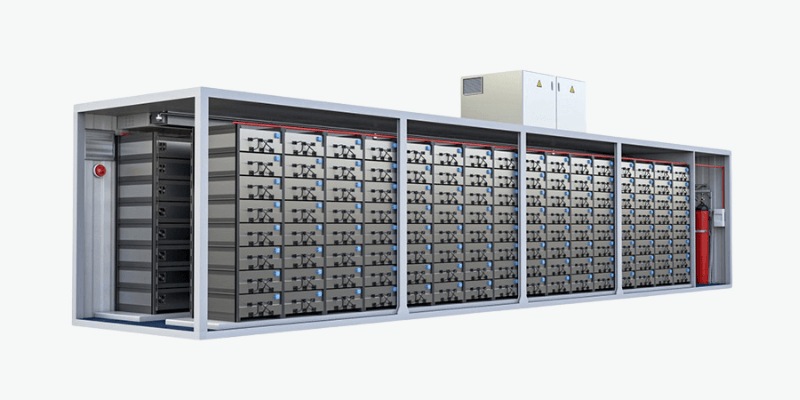Las baterías eléctricas del vehículo y las baterías de iones de litio para el almacenamiento de energía tienen requisitos distintos, a pesar de que ambos son iones de litio. Comprender sus diferencias puede ayudar a determinar la mejor batería para sus necesidades, ya que no existe un enfoque único para todos.
¿De qué es una batería de iones de litio para el almacenamiento de energía?
Las aplicaciones de almacenamiento de energía requieren baterías que sean altamente confiables, duraderas y seguras.
Nuestra solución utiliza un cátodo de fosfato de hierro de litio (LFP), que es ideal para estos requisitos. La menor interacción entre el cátodo LFP y el electrolito contribuye significativamente a su vida superior al ciclo y estabilidad térmica. Esto minimiza el riesgo de fuga térmica, una condición potencialmente peligrosa en algunas baterías de iones de litio.
Si bien LFP ofrece una fiabilidad y seguridad excepcionales, tiene una densidad de energía más baja en comparación con otros químicos de iones de litio como el óxido de cobalto de litio (LCO) o el óxido de cobalto de níquel de litio (NMC). En consecuencia, las baterías LFP suelen ser más pesadas para una cantidad dada de energía, que es menos ideal para vehículos eléctricos.

¿De qué es una batería de iones de litio para vehículos eléctricos?
Los vehículos eléctricos necesitan baterías de alta densidad de energía para alimentar tanto el automóvil como sus sistemas a bordo.
La mayoría de los autos eléctricos usan baterías de iones de litio con níquel y cátodos de cobalto, llamados baterías NMC. Estos proporcionan una fuente de energía más densa para la propulsión del vehículo en comparación con las baterías LFP.
El electrolito líquido orgánico en las baterías NMC reacciona con oxígeno, especialmente a altas temperaturas. Esta reactividad puede conducir a explosiones y otros problemas potenciales relacionados con el fugitivo térmico.

¿Cuáles son las diferencias entre las baterías de iones de litio para el almacenamiento de energía y las baterías de iones de litio para vehículos eléctricos?
Las baterías LFP y NMC son excelentes soluciones de potencia, pero tienen diferencias clave que las hacen adecuadas para tareas específicas.
Material de cátodo
Las baterías de iones de litio usan un cátodo para generar energía.
Las baterías de almacenamiento de energía usan LFP, mientras que las baterías eléctricas del vehículo usan NMC.
Las baterías NMC tienen densidades de energía más altas, mejorando la aceleración. Las baterías LFP ofrecen almacenamiento de energía superior en comparación con NMC.
Enlace de oxígeno
Las baterías NMC y LFP requieren un electrolito para reaccionar con oxígeno. Sin embargo, las baterías NMC tienen un enlace de oxígeno más flexible, lo que las hace más propensas a las explosiones fugitivas térmicas y potenciales.
En contraste, las baterías LFP tienen menos probabilidades de experimentar fugas térmicas, lo que las convierte en una opción más segura en general.

Carga & Descarga
Las baterías NMC tienen densidades de potencia más altas que las baterías LFP, lo que permite una carga y descarga más rápidas.
Proceso de envejecimiento de la batería
Las baterías NMC funcionan a 3.7 V, más altas que las 3.2V de las baterías LFP. Este mayor voltaje conduce a una degradación más rápida a medida que envejece la batería.
baterías LFP’ El voltaje inferior de 3.2V proporciona una mayor estabilidad del cátodo, lo que resulta en una mayor duración de la batería.
La molécula LFP más grande también permite una expansión y contracción más fácil durante el ciclo, lo que permite que las baterías de LFP resisten miles de ciclos a lo largo de su vida útil.
Costo
Las baterías LFP son generalmente más rentables por ciclo, lo que las hace atractivas para la eficiencia de rentabilidad a largo plazo.
Las baterías NMC son más caras debido a su cátodo, pero pueden ser rentables donde el espacio y el peso son limitaciones, gracias a su rendimiento y su tamaño compacto.
¿A qué voltaje funciona una batería de iones de litio para el almacenamiento de energía?
Las baterías de iones de litio diseñadas para el almacenamiento de energía funcionan a 3.2 voltios por celda. Este voltaje coincide con las baterías de plomo-ácido, lo que hace que las baterías LFP adecuadas para sistemas de almacenamiento de 12, 24 o 48 voltios.

¿A qué voltaje funciona una batería de iones de litio para vehículos eléctricos?
Las baterías de automóviles eléctricos funcionan a 3.7 voltios por celda, con voltajes de paquete de alrededor de 400 voltios. El voltaje más alto aumenta las interacciones entre el electrolito y el cátodo, proporcionando más potencia pero reduciendo la duración de la batería. Esta compensación puede no ser ideal para el almacenamiento estacionario, pero se adapta a las necesidades de alimentar vehículos eléctricos.
Conclusión
Si bien las baterías de iones de litio se utilizan tanto para el almacenamiento de energía como para los vehículos eléctricos, sus requisitos específicos han llevado a distintas químicas de batería.
Los sistemas de almacenamiento de energía priorizan la confiabilidad, la longevidad y la seguridad, lo que hace que las baterías de fosfato de hierro de litio (LFP) sean ideales. Su estabilidad térmica y su ciclo de vida se adaptan a aplicaciones estacionarias.
Sin embargo, los vehículos eléctricos exigen una alta densidad de energía para maximizar el rango de conducción y el rendimiento, lo que lleva a los fabricantes a favorecer las baterías de iones de litio con cáculos a base de níquel y cobalto (NMC). Aunque un poco menos estable que LFP, las baterías NMC pueden empacar más energía en un paquete más pequeño y más ligero – crítico para aplicaciones móviles.

